Chinese Festival Food
Many countries have traditional festivals and China, with its long history, is no exception. Chinese festivals reflect the diverse cultural heritage of its many ethnic groups. Food plays a very important part in any celebrations and what better way can one celebrate but by enjoying rich and colorful occasions with special tasty dishes. So, what are the festival foods?
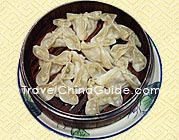
![]() Dumpling
Dumpling
People in northern China typically will eat dumplings (jiaozi) on New Year's Eve. This occurs because 'jiaozi' sounds like a word meaning 'bidding farewell to the old and ushering in the new.' in Chinese. Dumplings are always made before midnight and eaten during the last hour of the old year and the first hour of the Lunar New Year. Some people like to wrap a one-yuan, fifty-cent or ten-cent coin in some of the dumplings, as a token of good fortune for those who eat them. This is said to ensure good luck and prosperity in the New Year.![]() 7 Chinese New Year Foods that will Bring You Good Luck
7 Chinese New Year Foods that will Bring You Good Luck
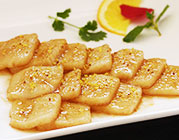
![]() Niangao (Rice Cake)
Niangao (Rice Cake)
Southern China produces rice, so traditionally the southern Chinese usually eat Niangao (rice cakes) to celebrate the New Year. This belief derives from the Chinese pronunciation of rice cake as 'niangao', a homophone for a word meaning a higher level of life. Niangao is made of glutinous rice powder and can be cooked by frying, steaming, stir-frying or boiling. With the development of the social culture, eating Niangao is also popular now among some people in north China during the Chinese New Year (Spring Festival).
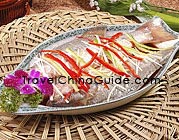
![]() Fish (Braised Pomfret, Tangba Town's Stir-fried Fish, Steamed Perch)
Fish (Braised Pomfret, Tangba Town's Stir-fried Fish, Steamed Perch)
Fish, usually of a local variety, is an important item on the dinning table of thousands of families on the eve of the Chinese New Year. Fish is pronounced 'yu' in Chinese, with the implications of having more than just a basic need each year. It is also a present exchanged between relatives and friends during the Chinese New Year. In southern China, some people just eat the middle part of the fish on the New Year Eve, leaving the head and tail to the next day to symbolize completeness. Meanwhile, it is particularly important that when fish is placed on the dining table, its head must be at the elders, as a sign of respect.
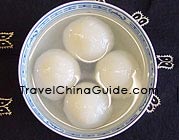
![]() Yuanxiao
Yuanxiao
Since the Song Dynasty (960-1279), people have had the custom of dining on traditional fare highlighted by 'Yuanxiao' on the Lantern Festival which is also called Yuanxiao Festival. Yuanxiao is a kind of rice dumpling made of glutinous rice powder and wrapped with various fillings like bean paste, brown sugar and all kinds of fruits and nuts. People eat these on the last day of the Chinese New Year celebration, since they are also named 'tangyuan' or 'tuanyuan' among the Chinese folk, pronounced like 'tuanyuan' (reunion).
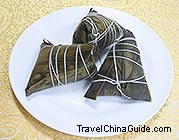
![]() Zongzi
Zongzi
Throughout the country families will eat 'zongzi' to memorize the national hero Qu Yuan (he ended his life by drowning in the Miluo River on hearing his state was defeated.) on the Dragon Boat Festival, the day of Qu Yuan's death. Zongzi is pyramid-shaped dumplings made of glutinous rice and wrapped in bamboo or reed leaves, usually made into sweet with dates in northern China. However, it can be either sweet or savory and made from a great variety of ingredients besides glutinous rice, such as meat, shrimp, bean paste and nuts in southern China.
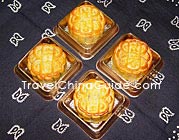
![]() Moon Cake
Moon Cake
Offering sacrifices to the moon, eating moon cakes and watching the moon are the main activities on Mid-Autumn Day. Moon cakes are usually round-shaped, representing family reunion and bright life. They are made with a sweet bean-paste filling, and a golden brown flaky skin, but nowadays, there are more than a dozen variations, including bean paste, yolk paste, coconut paste, five-core paste and so on. To make them attractive, some clever cooks decorate the moon cakes by drawing the pattern of 'Chang Er's Flying to the Moon'.
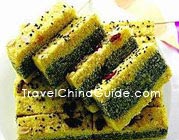
![]() Chongyang Cake
Chongyang Cake
Climbing mountains is a popular custom in China on Chongyang Festival, with the implication of promoting to a higher position. However, there isn't a mountain in some areas of China, so some people thought of eating 'gao' (cakes of rice or bean powder) instead, hence its name. In the past, the newly married daughters would go back home to spend the festival together with their parents, so the cakes were decorated with Chinese dates, millet, almond or peanuts, This signifies the parent’s good wishes for their daughters to give birth to a child in the near future.
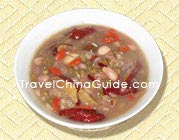
![]() Laba Porridge
Laba Porridge
Eating Laba Porridge also named 'Eight Porridge' is the focal point of the celebration on Laba Festival, the day when Sakyamuni became Buddha. People cook the porridge specially to offer sacrifices to the divinities and ancestors to pray for bountiful harvests and auspicious events in the coming year on the day. Originally, the porridge was made with rice and red beans. Now, the main ingredients are various types of rice and millet and a wide assortment of nuts and dried fruits, all being very nutritious. The porridge cooks all night long and has an enticing aroma that can be savored from a great distance.
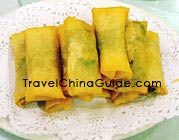
![]() Spring Rolls
Spring Rolls
Spring Rolls also named Spring Cakes by some northern Chinese, have a long history in China. It's said that as early as in the Eastern Jin Dynasty (316-420), people would eat 'Spring Plate', a dish with thin flour-made cakes at the center of the plate and green vegetables around them, on the First Day of Spring every year. Along with the development of the cooking techniques, 'Spring Cakes' have been evolved into the present lovely golden spring rolls made of thin flour wrappers with various fillings – sweet or savory, meat or vegetables.